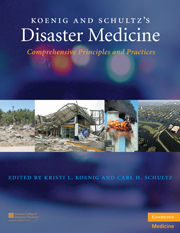Book contents
- Frontmatter
- Contents
- List of Contributors
- Contributor Biographies
- Foreword
- Preface
- Acknowledgments
- PART I CONCEPTUAL FRAMEWORK AND STRATEGIC OVERVIEW
- PART II OPERATIONAL ISSUES
- PART III CLINICAL MANAGEMENT
- SECTION A CBRNE AND HAZMAT
- SECTION B ENVIRONMENTAL EVENTS
- 32 Floods
- 33 Cyclones/Hurricanes/Typhoons
- 34 Tornadoes
- 35 Earthquakes
- 36 Tsunamis
- 37 Winter Storms
- 38 Extreme Heat Events
- 39 Volcanoes
- Index
- Plate section
- References
34 - Tornadoes
from SECTION B - ENVIRONMENTAL EVENTS
Published online by Cambridge University Press: 05 August 2011
- Frontmatter
- Contents
- List of Contributors
- Contributor Biographies
- Foreword
- Preface
- Acknowledgments
- PART I CONCEPTUAL FRAMEWORK AND STRATEGIC OVERVIEW
- PART II OPERATIONAL ISSUES
- PART III CLINICAL MANAGEMENT
- SECTION A CBRNE AND HAZMAT
- SECTION B ENVIRONMENTAL EVENTS
- 32 Floods
- 33 Cyclones/Hurricanes/Typhoons
- 34 Tornadoes
- 35 Earthquakes
- 36 Tsunamis
- 37 Winter Storms
- 38 Extreme Heat Events
- 39 Volcanoes
- Index
- Plate section
- References
Summary
OVERVIEW
Tornadoes occur worldwide, with the greatest incidence in North America. Australia ranks second in incidence to the United States while countries such as Italy, New Zealand, and the United Kingdom rival this incidence if it is expressed as tornadoes per area rather than in absolute numbers. Tornadoes sometimes occur with very little or no advanced warning, causing considerable structural damage, traumatic injury, and death. Although meteorologists are capable of advanced forecasting of weather conditions that favor tornado development, the exact touchdown location and ground track of a tornado is not yet predictable. Even with advanced warning, there are still the challenges of notifying the population at risk and communicating the correct response to minimize injury or death.
Historical data reveal similar patterns of injury and death in all tornado disasters. Community healthcare systems face significant challenges in attempting to manage the influx of tornado casualties. The sudden surge in patient volume, added to the routine daily challenge of providing medical care in hospitals functioning near 100% capacity, can overwhelm an already stressed healthcare system.
The track of destruction and injury produced by tornadoes is relatively small in proportion to the exposed population. The occurrence of a “worse-case scenario,” the impact of a large tornado on a densely populated event located at a fairgrounds or sports arena, could produce significant casualty numbers. Fort Worth, Texas had such a near miss when a sudden massive hailstorm caught 10,000 spectators in an open area.
Keywords
- Type
- Chapter
- Information
- Koenig and Schultz's Disaster MedicineComprehensive Principles and Practices, pp. 553 - 561Publisher: Cambridge University PressPrint publication year: 2009



